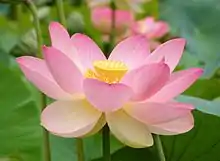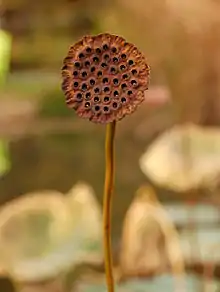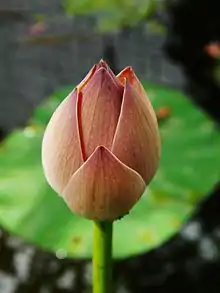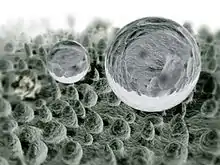Nelumbo
Nelumbo is a genus of aquatic plants with large, showy flowers. Members are commonly called lotus, though "lotus" is a name also applied to various other plants and plant groups, including the unrelated genus Lotus. Members outwardly resemble those in the family Nymphaeaceae ("water lilies"), but Nelumbo is actually very distant to Nymphaeaceae. "Nelumbo" is derived from the Sinhalese word Sinhala: නෙළුම් neḷum, the name for the lotus Nelumbo nucifera.[1]
| Nelumbo | |
|---|---|
 | |
| N. nucifera (sacred lotus) | |
| Scientific classification | |
| Kingdom: | Plantae |
| Clade: | Tracheophytes |
| Clade: | Angiosperms |
| Clade: | Eudicots |
| Order: | Proteales |
| Family: | Nelumbonaceae |
| Genus: | Nelumbo Adans. |
| Species | |
| |
There are only two known living species of lotus; N. nucifera is native to East Asia, South Asia and Southeast Asia and is better-known. It is commonly cultivated; it is eaten and used in traditional Chinese medicine. This species is the floral emblem of both India and Vietnam.
The other lotus is Nelumbo lutea and is native to North America and the Caribbean. Horticultural hybrids have been produced between these two allopatric species.
There are several fossil species known from Cretaceous, Paleogene and Neogene aged strata throughout Eurasia and North America.
Species
_01.jpg.webp)

Extant species
- Nelumbo lutea Willd. – American lotus (Eastern United States, Mexico, Greater Antilles, Honduras)
- Nelumbo nucifera Gaertn. – sacred or Indian lotus, also known as the Rose of India and the sacred water lily of Hinduism and Buddhism.[2] It is the national flower of India and Vietnam. Its roots and seeds are also used widely in cooking in East Asia, South Asia and Southeast Asia.


Fossil species
- †Nelumbo aureavallis Hickey – Eocene (North Dakota), described from leaves found in the Golden Valley Formation in North Dakota, USA.[3]
- †Nelumbo changchangensis Eocene, (Hainan Island, China), described from several fossils of leaves, seedpods, and rhizomes from the Eocene-aged strata in the Changchang Basin, of Hainan Island.
- †Nelumbo minima Pliocene (Netherlands), described from leaves and seedpods that suggest a very small plant. Originally described as a member of the genus Nelumbites, as "Nelumbites minimus."
- †Nelumbo nipponica Eocene-Miocene, fossil leaves are known from Eocene-aged strata in Japan, and Miocene-aged strata in Russia.
- †Nelumbo orientalis Cretaceous (Japan), one of the oldest known species, fossils are found in Cretaceous-aged strata of Japan.
- †Nelumbo protolutea Eocene (Mississippi), fossils of leaves strongly suggest a plant similar in form to the American lotus.
Classification
There is residual disagreement over which family the genus should be placed in. Traditional classification systems recognized Nelumbo as part of the Nymphaeaceae, but traditional taxonomists were likely misled by convergent evolution associated with an evolutionary shift from a terrestrial to an aquatic lifestyle. In the older classification systems it was recognized under the biological order Nymphaeales or Nelumbonales. Nelumbo is currently recognized as the only living genus in Nelumbonaceae, one of several distinctive families in the eudicot order of the Proteales. Its closest living relatives, the (Proteaceae and Platanaceae), are shrubs or trees.
The leaves of Nelumbo can be distinguished from those of genera in the Nymphaeaceae as they are peltate, that is they have fully circular leaves. Nymphaea, on the other hand, has a single characteristic notch from the edge in to the center of the lily pad. The seedpod of Nelumbo is very distinctive.
APG
-_water_drops_W_IMG_8657.jpg.webp)
The APG IV system of 2016, recognizes Nelumbonaceae as a distinct family and places it in the order Proteales in the eudicot clade, as do the earlier APG III and APG II systems.[4]
Earlier classification systems
The Cronquist system of 1981 recognizes the family but places it in the water lily order Nymphaeales. The Dahlgren system of 1985 and Thorne system of 1992 both recognize the family and place it in its own order, Nelumbonales. The USDA still classifies the lotus family within the water lily order.[5]
Characteristics
Ultrahydrophobicity
The leaves of Nelumbo are highly water-repellent (i.e. they exhibit ultrahydrophobicity) and have given the name to what is called the lotus effect.[6] Ultrahydrophobicity involves two criteria: a very high water contact angle between the droplet of water and the leaf surface, and a very low roll-off angle.[7] This means that the water must contact the leaf surface at exactly one, minuscule point, and any manipulation of the leaf by changing its angle will result in the water droplet rolling off of the leaf.[7] Ultrahydrophobicity is conferred by the usually dense layer of papillae on the surface of the Nelumbo leaves, and the small, robust, waxy tubules that protrude off each papillae.[8] This helps reduce the area of contact between the water droplet and the leaf.[8]
Ultrahydrophobicity is said to confer a very important evolutionary advantage. As an aquatic plant with leaves that rest on the water's surface, the genus Nelumbo is characterized by its concentration of stomata on the upper epidermis of its leaves, unlike most other plants which concentrate their stomata on the lower epidermis, underneath the leaf.[8] The collection of water on the upper epidermis, whether that be by rain, mist, or the nearby disturbance of water, is very detrimental to the leaf's ability to perform gas exchange through its stomata. Thus, Nelumbo's ultrahydrophobicity allows the water droplets to accumulate together very quickly, and then roll off of the leaf very easily at the slightest disturbance of the leaf, a process which allows its stomata to function normally without restriction due to blockage by water droplets.[9]
Thermoregulation
A unique property of the genus Nelumbo is that it can generate heat,[10] which it does by using the alternative oxidase pathway (AOX).[11][12] This pathway involves a different, alternative exchange of electrons from the usual pathway that electrons follow when generating energy in mitochondria, known as the AOX, or alternative oxidase pathway.
The typical pathway in plant mitochondria involves cytochrome complexes. The pathway used to generate heat in Nelumbo involves cyanide-resistant alternative oxidase, which is a different electron acceptor than the usual cytochrome complexes.[13] The plant also reduces ubiquitin concentrations while in thermogenesis, which allows the AOX in the plant to function without degradation[14] Thermogenesis is restricted to the receptacle, stamen, and petals of the flower, but each of these parts produce heat independently without relying on the heat production in other parts of the flower.[15]
There are several theories about the function of thermogenesis, especially in an aquatic genus such as Nelumbo. The most common theory posits that thermogenesis in flowers attracts pollinators, for a variety of reasons. Heated flowers may attract insect pollinators. As the pollinators warm themselves while resting inside the flower, they deposit and pick up pollen onto and from the flower.[10] The thermogenic environment might also be conducive to pollinator mating - pollinators may require a certain temperature for reproduction. By providing an ideal thermogenic environment, the flower is pollinated by mating pollinators.[16] Others theorize that heat production facilitates the release of volatile compounds into the air to attract pollinators flying over water, or that the heat is recognizable in the dark by thermo-sensitive pollinators. None have been conclusively proven to be more plausible than the others.[17]
After anthesis, the receptacle of the lotus transitions from a primarily thermogenic to a photosynthetic structure, as seen in the rapid and dramatic increase in photosystems, photosynthetically involved pigments, electron transport rates, and the presence of 13C in the receptacle and petals, all of which assist in increasing photosynthesis rates.[18] After this transition, all thermogenesis in the flower is lost. Pollinators do not need to be attracted once the ovary is fertilized, and thus the receptacle's resources are better used when it is photosynthesizing to produce carbohydrates that can increase plant biomass or fruit mass.[16]
Other plants utilize thermoregulation in their life cycles. Among these is the eastern skunk cabbage, which heats itself to melt any ice above it, and push through the ground in early spring,.[19] Also, the elephant yam, which heats its flowers to attract pollinators. In addition, the carrion flower, which heats itself to disperse water vapor through the air, carrying its scent further, thus attracting more pollinators.
References
- Hyam R, Pankhurst RJ (1995). Plants and their names : a concise dictionary. Oxford: Oxford University Press. ISBN 978-0-19-866189-4.
- "Nelumbo nucifera (sacred lotus)". Kew Royal Botanic Gardens. Archived from the original on 30 May 2014. Retrieved 26 July 2015.
- Hickey L (1977). Stratigraphy and Paleobotany of the Golden Valley Formation (Early Tertiary) of Western North Dakota. Boulder, Colorado: Geological Society of America. pp. 110 & Plate 5. ISBN 978-0-8137-1150-8.
- Angiosperm Phylogeny Group (2016). "An update of the Angiosperm Phylogeny Group classification for the orders and families of flowering plants: APG IV". Botanical Journal of the Linnean Society. 181 (1): 1–20. doi:10.1111/boj.12385. ISSN 0024-4074.CS1 maint: uses authors parameter (link)
- http://plants.sc.egov.usda.gov/core/profile?symbol=NENU2, Click on Classification tab, three to the right of the General tab under which the webpage opens. (It is all the same web address.)
- Darmanin T, Guittard F (1 June 2015). "Superhydrophobic and superoleophobic properties in nature". Materials Today. 18 (5): 273–285. doi:10.1016/j.mattod.2015.01.001.
- Marmur A (2004-04-01). "The Lotus Effect: Superhydrophobicity and Metastability". Langmuir. 20 (9): 3517–3519. doi:10.1021/la036369u. PMID 15875376.
- Zhang Y, Wu H, Yu X, Chen F, Wu J (March 2012). "Microscopic Observations of the Lotus Leaf for Explaining the Outstanding Mechanical Properties". Journal of Bionic Engineering. 9 (1): 84–90. doi:10.1016/S1672-6529(11)60100-5.
- Ensikat HJ, Ditsche-Kuru P, Neinhuis C, Barthlott W (2011-03-10). "Superhydrophobicity in perfection: the outstanding properties of the lotus leaf". Beilstein Journal of Nanotechnology. 2: 152–61. doi:10.3762/bjnano.2.19. PMC 3148040. PMID 21977427.
- Watling JR, Robinson SA, Seymour RS (April 2006). "Contribution of the alternative pathway to respiration during thermogenesis in flowers of the sacred lotus". Plant Physiology. 140 (4): 1367–73. doi:10.1104/pp.105.075523. PMC 1435819. PMID 16461386.
- Seymour RS, Schultze-Motel P, Lamprecht I (1 July 1998). "Heat production by sacred lotus flowers depends on ambient temperature, not light cycle". Journal of Experimental Botany. 49 (324): 1213–1217. doi:10.1093/jxb/49.324.1213.
- Grant NM, Miller RA, Watling JR, Robinson SA (2010-11-12). "Distribution of thermogenic activity in floral tissues of Nelumbo nucifera". Functional Plant Biology. 37 (11): 1085–1095. doi:10.1071/FP10024. ISSN 1445-4416.
- Hiroma T, Ito K, Hara M, Torisu R (2011-06-01). "Analysis of the Lotus Thermoregulation System from the Perspective of Control Engineering". Shokubutsu Kankyo Kogaku (in Japanese). 23 (2): 52–58. doi:10.2525/shita.23.52. ISSN 1880-2028.
- Wang R, Zhang Z (March 2015). "Floral thermogenesis: An adaptive strategy of pollination biology in Magnoliaceae". Communicative & Integrative Biology. 8 (1): e992746. doi:10.4161/19420889.2014.992746. PMC 4594551. PMID 26844867.
- Li JK, Huang SQ (May 2009). "Flower thermoregulation facilitates fertilization in Asian sacred lotus". Annals of Botany. 103 (7): 1159–63. doi:10.1093/aob/mcp051. PMC 2707905. PMID 19282320.
- Miller RE, Watling JR, Robinson SA (2009). "Functional transition in the floral receptacle of the sacred lotus (Nelumbo nucifera): from thermogenesis to photosynthesis". Functional Plant Biology. 36 (5): 471–480. doi:10.1071/FP08326.
- Wagner AM, Krab K, Wagner MJ, Moore AL (2008-07-01). "Regulation of thermogenesis in flowering Araceae: the role of the alternative oxidase". Biochimica et Biophysica Acta (BBA) - Bioenergetics. 1777 (7–8): 993–1000. doi:10.1016/j.bbabio.2008.04.001. PMID 18440298.
- Grant NM, Miller RE, Watling JR, Robinson SA (2008-02-01). "Synchronicity of thermogenic activity, alternative pathway respiratory flux, AOX protein content, and carbohydrates in receptacle tissues of sacred lotus during floral development". Journal of Experimental Botany. 59 (3): 705–14. doi:10.1093/jxb/erm333. PMID 18252702.
- Ito K, Ito T, Onda Y, Uemura M (2004-03-15). "Temperature-Triggered Periodical Thermogenic Oscillations in Skunk Cabbage (Symplocarpus foetidus)". Plant and Cell Physiology. 45 (3): 257–264. doi:10.1093/pcp/pch038. ISSN 0032-0781. PMID 15047873.
External links
| Wikimedia Commons has media related to Nelumbo. |
| Wikispecies has information related to Nelumbo. |